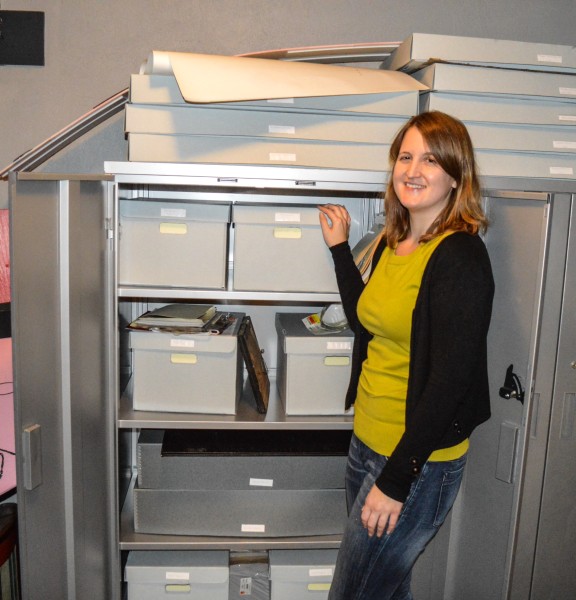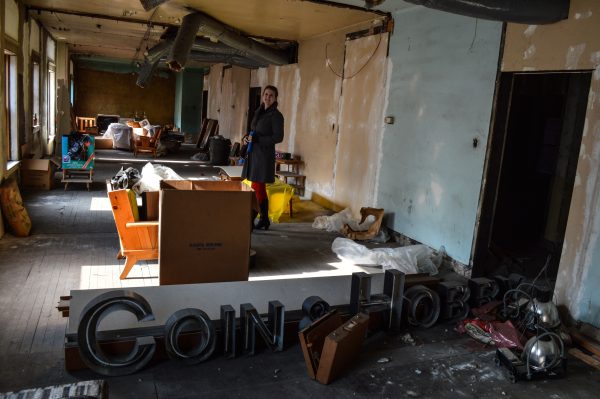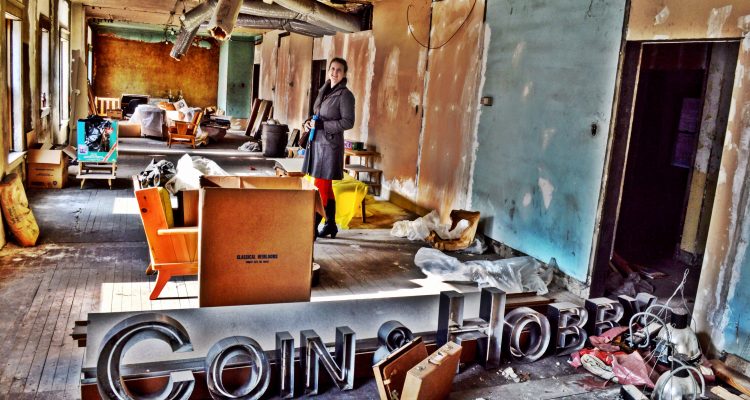By Steve Novotney
Weelunk.com
Rebekah Karelis never really knows what her workday will entail when she walks through the front doors of Wheeling’s Artisan Center each morning.
What treasures have been discovered? What secrets will be revealed?
Karelis works for the Wheeling National Heritage Area Corporation (“WNHAC”) as the historian, and that means on an everyday basis she is presented with a new piece of the Friendly City’s story.
“My actual title is, ‘historian’, but to really explain what it is I do, I would have to explain all of the projects that I get to work on,” she said. “In the beginning I was referred to as an archivist because I was part-time for a few years.
“I have had the chance to work on so many great projects like the Capitol Theatre and the Mount Wood Cemetery, and I have also been involved with a lot of publications as well,” she said. “And I really never know what I may encounter when I go to work every morning, and that’s exactly what is so cool about this job.
“The mission of WNHAC includes trying to preserve, interpret, and communicate the history to the public,” Karelis said. “So that’s what we are trying to do with everything that we do, but it is difficult. If people aren’t looking for it, then they won’t see it. But Wheeling has really, really incredible stories.”

Karelis is a native of West Virginia’s Mineral County, and she obtained her undergraduate degree in archeology and her Master’s Degree in public history from West Virginia University. One of her class assignments directed her to Wheeling and to Belmont College’s preservation program. Once her visit was complete, she was convinced of two things: First, she knew she had to enroll in Belmont College’s preservation program; and second, the city of Wheeling is a mecca of history.
Today, as Wheeling’s official historian, Karelis usually does not have to leave the confines of the WNHAC office on the Artisan Center’s third floor, and that’s because she normally has a steady stream of local citizens interested in being involved with the collection of Wheeling history.
“It turned to be one of those ‘If-you-look-for-it-it-will-come.’ Once the word got out to the public that there was someone working on this, people started calling or stopping by the office,” Karelis said. “So these materials usually come to me instead of me having to go look for them.
“I go out into the community, too, if anyone is interested in sitting down with me, or if they have collections of memorabilia about their families or anything else,” Karelis said. “I like to help them by scanning their photos. That way, WNHAC gets a copy for our archives, and they get the digital versions so they can share them more easily.
“If they have the chance to share it with their family and friends, that’s a part of preservation, too,” she said. “It all goes toward a collection we are building because we hope to be able to share it with the Ohio County Public Library so it can be made available for everyone.”
An example of a recent discovery concerning the history of Wheeling involves the Flat Iron Building on the corner of Main and South streets. The structure, recently purchased by Kevin Duffin, was constructed and owned by the inventor of steel pipe.
“One of the things that I do is help to write National Registry nominations for the buildings here in Wheeling, and we just finished working on the nomination for the Riverside Iron Works Building, which is mostly known as the Flat Iron Building,” she said. “The building was built in 1894 by Riverside Iron Works, and the owner was Frank Hearne.
“Hearne was a pioneer at the time in the area of iron tubing or pipe,” Karelis explained. “At that time in history, the original gas boom was going on, and people also were starting to get running water in their houses.”
And the inventor was a Wheeling native.
“Frank Hearne was a local man. He grew up here, went away to study for a few years, and then he came back, and he was one of the first to produce steel pipe,” Karelis confirmed. “His processes would become the norm for steel pipe production, and it took place in downtown Wheeling.”

A portion of her position with WNHAC involves venturing into buildings that most people have never seen from the inside. Karelis toured the buildings within the 1100 block before demolition, and recently she viewed the interior of the former Wheeling Hotel on the corner of 10th and Main streets in downtown Wheeling. The Mount Wood Cemetery, located atop Wheeling Hill, also is a project Karelis adopted two years ago.
“For me personally, I love cemeteries, and this past year was monumental for Mount Wood. There was a lot of work completed because a lot of people volunteered and put their sweat into it,” she said. “Unless you are there and you actually do the work, you don’t understand how difficult it is. It’s kind of a daunting task.
“With that being said, we were able to get an incredible amount of work done,” Karelis added. “When we first got started two years ago, there were 1,000 stones that needed attention, and I had no idea how we were going to get it done with a bunch of volunteers. And the only way we can do anything is because of donations that have come from the community, and we still need a lot of money because there’s a lot more that should be done.”
“Before I started, it wasn’t anyone’s actual job to study the history of Wheeling, but that’s what I have been able to do in my role at WNHAC,” Karelis explained. “We have so many great historians here in Wheeling who have worked very, very hard for many years, but there are really not many up-and-coming people who can fill those roles when we lose those folks.
“It’s been a great opportunity for me because I’ve had the chance to learn from them,” she said. “The one thing I want to make sure of is that all of the work they have done is preserved and continues to teach future generations about the history of this city and of this entire valley.”





